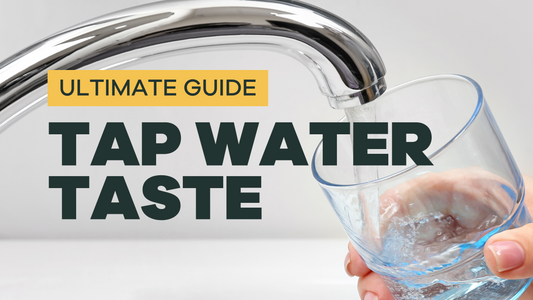
Quick Guide: Septic Tanks & Well Water Safety
Our blog is written by real experts— not AI. Each guide is carefully reviewed and updated based on the latest research. Plus, with no affiliate links, you can count on unbiased insights you can trust.
Understanding how a septic tank works and how it might interact with the safety of your well water is very important. In this quick guide to protecting your well water from septic tank issues, we’ll tackle questions about proper septic system upkeep and well water testing so you can keep everything running smoothly.
Table of Contents:
- How Septic Systems Work
- How Septic Systems Fail
- Risks to Drinking Water
- How to Prevent Drinking Water Contamination
- What to Test for in Your Drinking Water
- What’s the Takeaway?
How Does a Septic System Work?
Septic systems collect, transfer, and treat household liquid wastes before they leak and contaminate local ground and surface waters, like wells, aquifers, lakes, and streams.
Septic tanks are the collection units where wastes decompose and divide into liquids and solids.

- Waste is funneled through your household plumbing into your septic tank
- Solids in the wastewater either dissolve or settle as sludge
- Grease, scum, and sludge are separated from other waste material
- Resulting wastewater is sent into distribution section of the tank
- Purified wastewater is released through the output baffle into a drain field where it filters into the surrounding earth and fertilizes the soil
How Do Septic Systems Fail?
Septic tank failures can result in the contamination of local water sources. Causes of septic system failure include:
-
System failure due to clogging
Proper care is needed to avoid septic clogging and early-stage system failure. Poor maintenance practices such as disposing of oil, fats, and other inappropriate items down the drain can lead to clogging of the septic system.
-
Insufficient permeability of surrounding soil
Sometimes, your local soil is not particularly suitable for a septic system and will not allow passage of the liquid waste released into the leach field. This is an issue that is usually out of the hands of the homeowner.
-
High density of septic systems can lead to problems down the line
Even if septic systems are placed correctly in relation to wells, a particularly high density of septic systems in one area can be problematic. Waste from many septic systems can combine, which can present an increased hazard to water sources nearby.
How Do You Know If Your Septic Tank Is Full?
Here are six easy-to-spot signs that your septic tank is full:
- Water and/or waste drains slowly (in sinks, toilets, and showers/tubs)
- Gurgling sounds from your piping
- Frequent toilet and/or sink backups
- Unpleasant septic tank smells
- Water begins to pool in your yard
- Sudden growth of lush, green grass in your yard
What Risks Do Septic Systems Pose to Well Water?
While not all septic systems contaminate drinking water, septic system failures can introduce fecal coliform bacteria into well water. Sewage that hasn’t been properly treated by a septic system can cause disease that can impact both humans and other animals. These acute illnesses include:
- Dysentery
- Hepatitis
- Typhoid fever
- Acute gastrointestinal illnesses
Ignoring the risks can cause serious health hazards for your household.
How to Keep Your Septic System from Clogging and Contaminating Well Water Supplies
You can make the following adjustments to help prevent clogging of your septic system and reduce the risk of contaminating your well’s drinking water supply:
-
Schedule routine septic inspections and pumping.
We recommend you schedule a septic system inspection and pumping service once every three to four years. Without regular or proper pumping, blockages may occur even if you’re using your system properly.
Septic system inspections and pumping should only be performed by a certified inspector. If you do not have a private contractor in mind, you may contact your health department for assistance. -
Don’t let the wrong products go down the drain.
Some waste items simply aren’t meant to go into your septic system. All of these can lead to septic tank clogs or water contamination if clogs lead to system failure:
• Fats, greases, cooking oils
• Motor oils or fuels
• Coffee grounds, egg and nut shells
• Cleaners, bleach, paints, or chemicals
• Prescription medicines, feminine hygiene products or prophylactics
• Cigarette filters, paper towels, or rags -
Observe the warning signs.
This one may seem obvious, but it is easily overlooked. Listen for any odd gurgling sounds near your drains, pay attention to uncommon, foul odors, and check your lawn for any slow drainage or wet spots. These wet spots may be the first evidence of sewage leaking to the surface. -
Test your water.
Having issues with your septic system? A well water test might reveal a slew of contaminants that could indicate septic system issues. Our comprehensive home water test kits detect over 100 contaminants, providing you with a detailed water report from an accredited laboratory.
How To Test Your Well Water in a Lab
How Far Does a Well Need to Be From A Septic Tank?
A well should be at least 50 feet away from a septic tank or holding tank.[2] Additionally, release/drainage fields should be at least 100 feet from wells.
What to Test Your Water for if Your Well Is Near a Septic System
Common contaminants that may indicate your well is being contaminated by a nearby septic system include:
- Coliform bacteria like E. coli
- Phosphates
- Nitrogen containing compounds like ammonia, nitrate, and nitrite
We have designed a mail-to-lab test kit that covers all these contaminants and many more so you can be sure your septic system is not affecting the quality of your drinking water.
What’s the Takeaway?
- Issues with your septic system can lead to the contamination of both your own well water, and your community’s groundwater source
- Proper upkeep of your septic system—which prevents system clogging and backed up septic tanks—helps preserve the quality of your home’s drinking water.
- Septic system failure can be attributed to factors that you can control (like maintenance) and those that you cannot (like issues with the surrounding soil)









